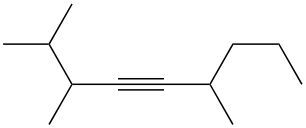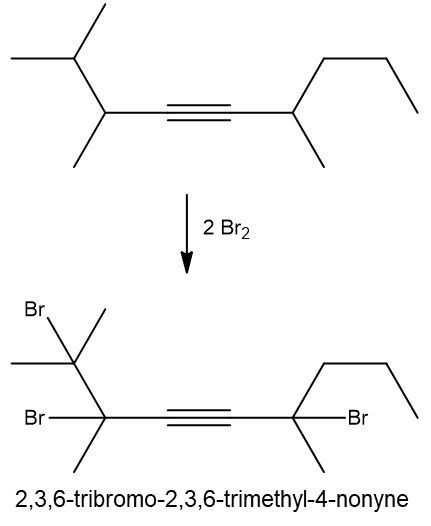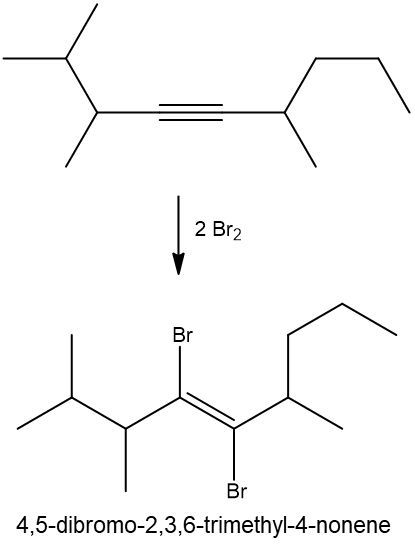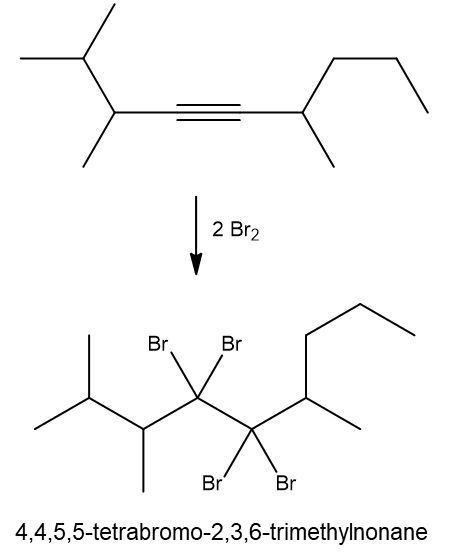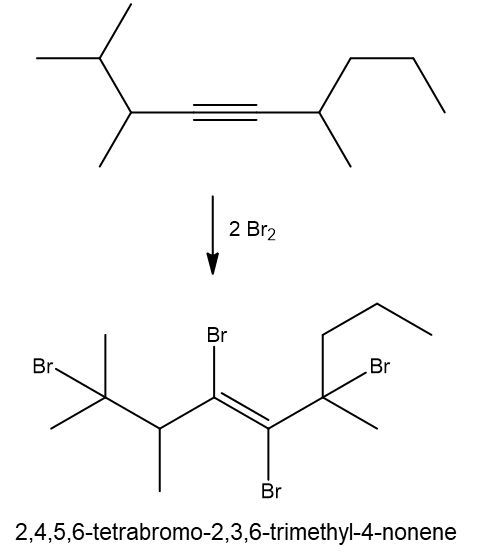In this reaction, we're going to talk about the halogenation reactions. Here, under this type of reaction, 2 halogens coming from either Br2 or Cl2 are added to 1 pi bond. So here we have our starting alkene, and we're reacting it with X2. In the process, each double-bonded carbon gains 1 halogen. At the end of this, we have a structure that has 2 halogens on it, which we call a dihalide. Now, if we have an alkyne that means we have 2 pi bonds. So remember, we need 1 mole of reagent for every pi bond. And since there's 2 pi bonds here, we'd need 2 moles of X2. The first mole would add, to give us 2 halogens, and then the second mole would add again, to give us another 2 halogens. At the end, you have a structure that possesses 4 halogens on it. So we'd call this a tetrahalide. So remember, halogenation is just adding 2 halogens per pi bond within your structure. This could give us a dihalide if you're dealing with an alkene, or a tetrahalide if you're dealing with an alkyne.
- 1. Matter and Measurements4h 29m
- What is Chemistry?5m
- The Scientific Method9m
- Classification of Matter16m
- States of Matter8m
- Physical & Chemical Changes19m
- Chemical Properties8m
- Physical Properties5m
- Intensive vs. Extensive Properties13m
- Temperature (Simplified)9m
- Scientific Notation13m
- SI Units (Simplified)5m
- Metric Prefixes24m
- Significant Figures (Simplified)11m
- Significant Figures: Precision in Measurements7m
- Significant Figures: In Calculations19m
- Conversion Factors (Simplified)15m
- Dimensional Analysis22m
- Density12m
- Specific Gravity9m
- Density of Geometric Objects19m
- Density of Non-Geometric Objects9m
- 2. Atoms and the Periodic Table5h 23m
- The Atom (Simplified)9m
- Subatomic Particles (Simplified)12m
- Isotopes17m
- Ions (Simplified)22m
- Atomic Mass (Simplified)17m
- Atomic Mass (Conceptual)12m
- Periodic Table: Element Symbols6m
- Periodic Table: Classifications11m
- Periodic Table: Group Names8m
- Periodic Table: Representative Elements & Transition Metals7m
- Periodic Table: Elemental Forms (Simplified)6m
- Periodic Table: Phases (Simplified)8m
- Law of Definite Proportions9m
- Atomic Theory9m
- Rutherford Gold Foil Experiment9m
- Wavelength and Frequency (Simplified)5m
- Electromagnetic Spectrum (Simplified)11m
- Bohr Model (Simplified)9m
- Emission Spectrum (Simplified)3m
- Electronic Structure4m
- Electronic Structure: Shells5m
- Electronic Structure: Subshells4m
- Electronic Structure: Orbitals11m
- Electronic Structure: Electron Spin3m
- Electronic Structure: Number of Electrons4m
- The Electron Configuration (Simplified)22m
- Electron Arrangements5m
- The Electron Configuration: Condensed4m
- The Electron Configuration: Exceptions (Simplified)12m
- Ions and the Octet Rule9m
- Ions and the Octet Rule (Simplified)8m
- Valence Electrons of Elements (Simplified)5m
- Lewis Dot Symbols (Simplified)7m
- Periodic Trend: Metallic Character4m
- Periodic Trend: Atomic Radius (Simplified)7m
- 3. Ionic Compounds2h 18m
- Periodic Table: Main Group Element Charges12m
- Periodic Table: Transition Metal Charges6m
- Periodic Trend: Ionic Radius (Simplified)5m
- Periodic Trend: Ranking Ionic Radii8m
- Periodic Trend: Ionization Energy (Simplified)9m
- Periodic Trend: Electron Affinity (Simplified)8m
- Ionic Bonding6m
- Naming Monoatomic Cations6m
- Naming Monoatomic Anions5m
- Polyatomic Ions25m
- Naming Ionic Compounds11m
- Writing Formula Units of Ionic Compounds7m
- Naming Ionic Hydrates6m
- Naming Acids18m
- 4. Molecular Compounds2h 18m
- Covalent Bonds6m
- Naming Binary Molecular Compounds6m
- Molecular Models4m
- Bonding Preferences6m
- Lewis Dot Structures: Neutral Compounds (Simplified)8m
- Multiple Bonds4m
- Multiple Bonds (Simplified)6m
- Lewis Dot Structures: Multiple Bonds10m
- Lewis Dot Structures: Ions (Simplified)8m
- Lewis Dot Structures: Exceptions (Simplified)12m
- Resonance Structures (Simplified)5m
- Valence Shell Electron Pair Repulsion Theory (Simplified)4m
- Electron Geometry (Simplified)8m
- Molecular Geometry (Simplified)11m
- Bond Angles (Simplified)11m
- Dipole Moment (Simplified)15m
- Molecular Polarity (Simplified)7m
- 5. Classification & Balancing of Chemical Reactions3h 17m
- Chemical Reaction: Chemical Change5m
- Law of Conservation of Mass5m
- Balancing Chemical Equations (Simplified)13m
- Solubility Rules16m
- Molecular Equations18m
- Types of Chemical Reactions12m
- Complete Ionic Equations18m
- Calculate Oxidation Numbers15m
- Redox Reactions17m
- Spontaneous Redox Reactions8m
- Balancing Redox Reactions: Acidic Solutions17m
- Balancing Redox Reactions: Basic Solutions17m
- Balancing Redox Reactions (Simplified)13m
- Galvanic Cell (Simplified)16m
- 6. Chemical Reactions & Quantities2h 35m
- 7. Energy, Rate and Equilibrium3h 46m
- Nature of Energy6m
- First Law of Thermodynamics7m
- Endothermic & Exothermic Reactions7m
- Bond Energy14m
- Thermochemical Equations12m
- Heat Capacity19m
- Thermal Equilibrium (Simplified)8m
- Hess's Law23m
- Rate of Reaction11m
- Energy Diagrams12m
- Chemical Equilibrium7m
- The Equilibrium Constant14m
- Le Chatelier's Principle23m
- Solubility Product Constant (Ksp)17m
- Spontaneous Reaction10m
- Entropy (Simplified)9m
- Gibbs Free Energy (Simplified)18m
- 8. Gases, Liquids and Solids3h 25m
- Pressure Units6m
- Kinetic Molecular Theory14m
- The Ideal Gas Law18m
- The Ideal Gas Law Derivations13m
- The Ideal Gas Law Applications6m
- Chemistry Gas Laws16m
- Chemistry Gas Laws: Combined Gas Law12m
- Standard Temperature and Pressure14m
- Dalton's Law: Partial Pressure (Simplified)13m
- Gas Stoichiometry18m
- Intermolecular Forces (Simplified)19m
- Intermolecular Forces and Physical Properties11m
- Atomic, Ionic and Molecular Solids10m
- Heating and Cooling Curves30m
- 9. Solutions4h 10m
- Solutions6m
- Solubility and Intermolecular Forces18m
- Solutions: Mass Percent6m
- Percent Concentrations10m
- Molarity18m
- Osmolarity15m
- Parts per Million (ppm)13m
- Solubility: Temperature Effect8m
- Intro to Henry's Law4m
- Henry's Law Calculations12m
- Dilutions12m
- Solution Stoichiometry14m
- Electrolytes (Simplified)13m
- Equivalents11m
- Molality15m
- The Colligative Properties15m
- Boiling Point Elevation16m
- Freezing Point Depression9m
- Osmosis16m
- Osmotic Pressure9m
- 10. Acids and Bases3h 29m
- Acid-Base Introduction11m
- Arrhenius Acid and Base6m
- Bronsted Lowry Acid and Base18m
- Acid and Base Strength17m
- Ka and Kb12m
- The pH Scale19m
- Auto-Ionization9m
- pH of Strong Acids and Bases9m
- Acid-Base Equivalents14m
- Acid-Base Reactions7m
- Gas Evolution Equations (Simplified)6m
- Ionic Salts (Simplified)23m
- Buffers25m
- Henderson-Hasselbalch Equation16m
- Strong Acid Strong Base Titrations (Simplified)10m
- 11. Nuclear Chemistry56m
- BONUS: Lab Techniques and Procedures1h 38m
- BONUS: Mathematical Operations and Functions47m
- 12. Introduction to Organic Chemistry1h 34m
- 13. Alkenes, Alkynes, and Aromatic Compounds2h 12m
- 14. Compounds with Oxygen or Sulfur1h 6m
- 15. Aldehydes and Ketones1h 1m
- 16. Carboxylic Acids and Their Derivatives1h 11m
- 17. Amines38m
- 18. Amino Acids and Proteins1h 51m
- 19. Enzymes1h 37m
- 20. Carbohydrates1h 46m
- Intro to Carbohydrates4m
- Classification of Carbohydrates4m
- Fischer Projections4m
- Enantiomers vs Diastereomers8m
- D vs L Enantiomers8m
- Cyclic Hemiacetals8m
- Intro to Haworth Projections4m
- Cyclic Structures of Monosaccharides11m
- Mutarotation4m
- Reduction of Monosaccharides10m
- Oxidation of Monosaccharides7m
- Glycosidic Linkage14m
- Disaccharides7m
- Polysaccharides7m
- 21. The Generation of Biochemical Energy2h 8m
- 22. Carbohydrate Metabolism2h 22m
- 23. Lipids2h 26m
- Intro to Lipids6m
- Fatty Acids25m
- Physical Properties of Fatty Acids6m
- Waxes4m
- Triacylglycerols12m
- Triacylglycerol Reactions: Hydrogenation8m
- Triacylglycerol Reactions: Hydrolysis13m
- Triacylglycerol Reactions: Oxidation7m
- Glycerophospholipids15m
- Sphingomyelins13m
- Steroids15m
- Cell Membranes7m
- Membrane Transport10m
- 24. Lipid Metabolism1h 45m
- 25. Protein and Amino Acid Metabolism1h 37m
- 26. Nucleic Acids and Protein Synthesis2h 54m
- Intro to Nucleic Acids4m
- Nitrogenous Bases16m
- Nucleoside and Nucleotide Formation9m
- Naming Nucleosides and Nucleotides13m
- Phosphodiester Bond Formation7m
- Primary Structure of Nucleic Acids11m
- Base Pairing10m
- DNA Double Helix6m
- Intro to DNA Replication20m
- Steps of DNA Replication11m
- Types of RNA10m
- Overview of Protein Synthesis4m
- Transcription: mRNA Synthesis9m
- Processing of pre-mRNA5m
- The Genetic Code6m
- Introduction to Translation7m
- Translation: Protein Synthesis18m
Halogenation Reaction - Online Tutor, Practice Problems & Exam Prep
 Created using AI
Created using AIHalogenation reactions involve the addition of halogens (X2, such as Br2 or Cl2) to alkenes and alkynes. In alkenes, each double-bonded carbon gains one halogen, resulting in a dihalide. For alkynes, which contain two pi bonds, two moles of halogen are required, yielding a tetrahalide with four halogens. This process exemplifies an addition reaction, where the structure of the original hydrocarbon is modified by the introduction of functional groups, enhancing its chemical properties.
Halogenation Reactions Concept 1
Video transcript
Halogenation Reactions Example 1
Video transcript
Complete the following halogenation reaction. So here we have our alkene, and we're reacting it with 1 mole of chlorine. Remember, all that's going to happen here is we're going to sacrifice our pi bond in order to add 2 halogens to my structure. Each double bonded carbon gets a chlorine. Here it doesn't matter the orientation that you place the chlorine if it's up or down or whatever, all that matters is the connection. It's these 2 double bonded carbons that each need to have their chlorines. Here I decide to show them as being on opposite sides of each other, but I could easily show them being on the same side. We don't go into spatial orientation when it comes to a reaction like this. That's left for when we do organic 1 and organic 2. For right now, this would be our dihalide structure completed from the following halogenation reaction.
Write a halogenation reaction of the following alkyne with Br2 and name the product formed.
Do you want more practice?
Here’s what students ask on this topic:
What is a halogenation reaction in organic chemistry?
A halogenation reaction in organic chemistry involves the addition of halogen atoms (such as Br2 or Cl2) to a hydrocarbon. This reaction typically occurs with alkenes and alkynes. For alkenes, each carbon in the double bond gains one halogen, resulting in a dihalide. For alkynes, which have two pi bonds, two moles of halogen are required, leading to a tetrahalide with four halogens. This process is an example of an addition reaction, where the original hydrocarbon structure is modified by the introduction of halogen atoms, enhancing its chemical properties.
 Created using AI
Created using AIHow does halogenation of alkenes differ from halogenation of alkynes?
Halogenation of alkenes and alkynes differs primarily in the number of halogen atoms added. In alkenes, each double-bonded carbon gains one halogen atom, resulting in a dihalide. The general reaction can be represented as:
For alkynes, which contain two pi bonds, two moles of halogen are required. The first mole adds two halogens, and the second mole adds another two, resulting in a tetrahalide:
 Created using AI
Created using AIWhat are the products of halogenation of an alkene?
The products of halogenation of an alkene are dihalides. In this reaction, each carbon atom in the double bond of the alkene gains one halogen atom. For example, if we start with ethene (C2H4) and react it with bromine (Br2), the product will be 1,2-dibromoethane (C2H4Br2):
This reaction is an example of an addition reaction, where the double bond is broken, and two new single bonds are formed with the halogen atoms.
 Created using AI
Created using AIWhy are halogenation reactions important in organic chemistry?
Halogenation reactions are important in organic chemistry because they allow for the functionalization of hydrocarbons, making them more reactive and versatile for further chemical transformations. By adding halogens to alkenes and alkynes, chemists can create dihalides and tetrahalides, which serve as key intermediates in the synthesis of various organic compounds. These reactions are also used in the production of pharmaceuticals, agrochemicals, and polymers. Additionally, halogenation can help in the study of reaction mechanisms and the development of new synthetic methodologies.
 Created using AI
Created using AIWhat is the mechanism of halogenation of alkenes?
The mechanism of halogenation of alkenes involves a three-step process:
1. **Formation of the Halonium Ion:** The alkene reacts with a halogen molecule (X2), forming a cyclic halonium ion intermediate. This occurs when the pi electrons of the alkene attack the halogen molecule, leading to the formation of a three-membered ring with a positive charge on the halogen.
2. **Nucleophilic Attack:** The halonium ion is then attacked by a halide ion (X-), which opens the three-membered ring and forms a vicinal dihalide.
3. **Formation of the Dihalide:** The final product is a dihalide, where each carbon of the original double bond is bonded to a halogen atom.
This mechanism ensures the anti-addition of halogens, meaning the halogens add to opposite sides of the former double bond.
 Created using AI
Created using AIYour GOB Chemistry tutor
- If bromocyclohexane were converted into cyclohexene, what kind of reaction would that be?
- 2,2,3,3-Tetrabromopentane can be prepared by an addition reaction of excess Br2 with an alkyne. Draw the struc...
- Identify the type of reaction for the following:a. <IMAGE>b. <IMAGE>
- What alkene could you use to make the following products? Draw the structure of the alkene, and tell what othe...
